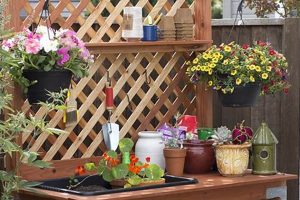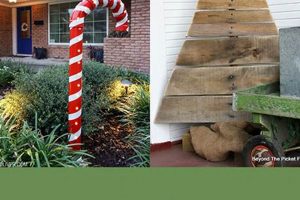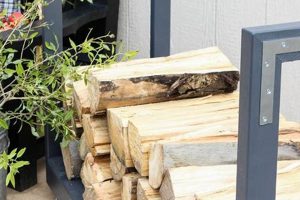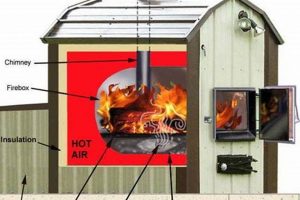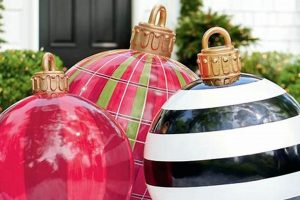A self-assembled washing station, typically situated in an exterior environment, offers a convenient space for cleaning tasks outside the confines of a building. Constructed from readily available materials or repurposed items, these installations can range from simple setups utilizing a bucket and spigot to more elaborate structures incorporating plumbing and drainage systems. A homemade fixture designed for use in gardens, patios, or workshops serves as a practical alternative to indoor plumbing for specific outdoor needs.
The utility of these installations stems from their ability to provide accessible water sources for various activities, such as gardening, food preparation, and handwashing. The presence of a designated area for these tasks reduces the need to track dirt and debris into interior spaces, contributing to overall cleanliness. Historically, such outdoor provisions were commonplace in rural settings and have seen a resurgence in popularity as individuals seek to enhance their outdoor living spaces with functional amenities. The reduced reliance on indoor water sources for exterior tasks translates to potential water conservation benefits.
The subsequent sections will address the key considerations in planning and constructing a functional and aesthetically pleasing unit. This includes material selection, plumbing options, structural design, and necessary safety precautions to ensure a durable and compliant installation.
Construction and Installation Guidelines
The following guidelines provide essential considerations for constructing and installing a washing station in an exterior setting, ensuring both functionality and longevity.
Tip 1: Material Selection: Prioritize weather-resistant materials. Treated lumber, stainless steel, or durable plastics withstand environmental exposure. Evaluate the structural integrity of chosen materials based on anticipated load and usage.
Tip 2: Plumbing Considerations: If connecting to a municipal water supply, ensure compliance with local plumbing codes. Consider a frost-free hose bib or a dedicated water line with appropriate backflow prevention devices. Proper pipe insulation minimizes the risk of freezing in colder climates.
Tip 3: Drainage Solutions: Plan for efficient water drainage. A French drain, dry well, or connection to an existing sewer line (subject to regulations) prevents water accumulation. Ensure proper grading to direct water away from the structure’s foundation.
Tip 4: Structural Stability: The structure must be stable and capable of supporting the weight of the sink basin, plumbing fixtures, and any stored items. Utilize appropriate fasteners and construction techniques to ensure a secure and durable build. Reinforce joints and connections as needed.
Tip 5: Accessibility and Ergonomics: Design the unit at a comfortable working height. Consider the user’s reach and mobility when positioning the sink and related accessories. Adequate space surrounding the area promotes ease of use.
Tip 6: Aesthetics and Integration: The unit’s design should complement its surrounding environment. Consider the style of existing structures and landscaping when selecting materials and finishes. A cohesive design enhances the overall aesthetic appeal.
Tip 7: Water Conservation: Incorporate water-saving fixtures, such as low-flow faucets or sprayers. Consider implementing a greywater system to reuse water for irrigation purposes (subject to local regulations). Minimize water waste through responsible usage habits.
Adherence to these guidelines contributes to the construction of a functional, durable, and aesthetically pleasing unit capable of withstanding the rigors of outdoor use.
The concluding section will summarize the key aspects and offer final recommendations for a successful project.
1. Durability
Durability represents a foundational attribute for any washing station intended for external use. The prolonged exposure to environmental elements necessitates careful consideration of materials and construction methods to ensure longevity and resistance to degradation. The selection criteria for components should prioritize resilience to weather, pests, and physical stress.
- Material Resistance to Environmental Factors
The selection of materials with inherent resistance to moisture, sunlight, and temperature fluctuations is paramount. Untreated wood, for example, is susceptible to rot and insect infestation, rendering it unsuitable for prolonged outdoor use. Conversely, pressure-treated lumber, stainless steel, and certain plastics offer superior resistance to these factors, extending the lifespan of the structure. This choice directly impacts the maintenance requirements and overall cost of ownership.
- Structural Integrity Under Load
The structure must withstand the combined weight of the sink basin, plumbing components, stored items, and potential external forces such as wind or snow. Insufficient structural support can lead to deformation, instability, and eventual failure. Employing appropriate load-bearing techniques and utilizing fasteners designed for outdoor applications are crucial for maintaining structural integrity over time.
- Resistance to Physical Damage
The location and intended use of the washing station influence the potential for physical damage. A unit situated in a high-traffic area or exposed to heavy machinery is more susceptible to impacts and abrasions. Selecting materials with high impact resistance and incorporating protective measures, such as bumpers or shields, can mitigate the risk of damage and prolong the unit’s lifespan.
- Joint and Connection Stability
The points at which individual components are joined represent potential weak points in the structure. Improperly secured joints are vulnerable to separation and failure, compromising the overall stability. Utilizing weatherproof adhesives, corrosion-resistant fasteners, and appropriate joinery techniques is essential for maintaining the integrity of these connections over time.
These interconnected aspects of durability are critical for ensuring that a homemade washing station provides reliable service in an outdoor environment. By prioritizing material selection, structural integrity, and resistance to physical damage, individuals can construct a unit that withstands the rigors of external use, minimizing the need for frequent repairs or replacements.
2. Accessibility
Accessibility, in the context of a washing station designed for external use, encompasses the ease with which individuals, regardless of physical ability, can utilize the fixture effectively and safely. Careful consideration of ergonomic principles and inclusive design practices is paramount in ensuring that the constructed unit meets the needs of all potential users.
- Counter Height and Reach
The height of the sink basin and surrounding countertop surfaces directly impacts user comfort and accessibility. A height that is too high or too low can strain the back and shoulders, particularly for individuals with mobility limitations. A counter height within the range of 30-34 inches typically accommodates a broad range of users, including those who utilize wheelchairs or other mobility aids. Furthermore, the depth of the countertop should be minimized to ensure that all areas of the sink basin and controls are within easy reach.
- Clearance and Maneuverability
Sufficient clear space surrounding the washing station is essential for unhindered movement. A minimum clear space of 30 inches by 48 inches allows individuals using wheelchairs or walkers to approach and maneuver around the fixture comfortably. Obstructions such as storage bins, gardening tools, or landscaping elements should be strategically placed to maintain clear pathways and minimize the risk of accidents or injuries.
- Faucet and Control Operability
The design of the faucet and associated controls should prioritize ease of use for individuals with limited dexterity or strength. Lever-style handles or touchless faucets offer greater accessibility compared to traditional knob-style faucets, which may require significant grip strength to operate. Placement of the controls should be within easy reach and require minimal effort to adjust water flow and temperature.
- Visual Cues and Contrast
Visual cues and high-contrast color schemes enhance accessibility for individuals with visual impairments. Clearly labeling controls with large, legible text and utilizing contrasting colors for faucet handles and surrounding surfaces improve visibility and reduce the risk of errors. Adequate lighting is also crucial for ensuring safe and effective use, particularly in low-light conditions.
By thoughtfully integrating these accessibility considerations into the design and construction of an external washing station, it is possible to create a fixture that is not only functional and durable but also inclusive and welcoming to all users. Addressing these aspects enhances the usability of the space, promoting independence and safety for individuals of diverse abilities.
3. Plumbing Integration
Plumbing integration represents a critical facet of any functioning washing station constructed in an external setting. The success of a “diy outdoor sink” hinges significantly on the correct and compliant connection to a water source and a means of wastewater disposal. A poorly executed plumbing system can lead to water damage, contamination, and violations of local codes, thereby rendering the entire project unusable. A direct and properly installed connection to a potable water supply, coupled with a compliant drainage system, transforms a basic structure into a functional utility. For example, a garden washing station requires a reliable water source for tasks such as rinsing produce and cleaning tools. Without proper plumbing integration, the washing station’s primary purpose is negated, forcing reliance on less convenient alternatives.
The complexity of plumbing integration varies based on factors such as the availability of existing water lines, local regulations, and the intended sophistication of the “diy outdoor sink”. A simple setup might involve connecting to an existing outdoor faucet via a hose and utilizing a bucket for wastewater collection. However, a more permanent and functional solution necessitates the installation of dedicated water lines and drainage systems. Practical applications of this understanding include selecting appropriate pipe materials, understanding water pressure requirements, and adhering to local plumbing codes regarding pipe sizing, slope, and venting. Ignoring these applications results in insufficient water flow, potential leaks, and the risk of backflow contamination.
In summary, plumbing integration is not merely an ancillary consideration but an integral component that defines the utility and legality of a “diy outdoor sink”. The selection of appropriate plumbing methods and adherence to local codes are paramount to ensuring a functional, safe, and sustainable washing station. Challenges in plumbing integration often stem from a lack of knowledge regarding plumbing principles or an underestimation of the importance of code compliance. Addressing these challenges through research and consultation with qualified professionals is essential for achieving a successful and reliable installation.
4. Drainage System
The drainage system represents an indispensable component of any functional “diy outdoor sink.” Its primary function is to efficiently and safely remove wastewater generated during use, preventing unsanitary conditions, soil erosion, and potential water damage to surrounding structures. The absence of a properly designed and implemented drainage system transforms the washing station into a potential source of environmental and structural problems. The direct cause and effect relationship is evident: wastewater accumulation leads to stagnation, odor generation, and the propagation of disease-carrying insects. For example, consider a “diy outdoor sink” used for cleaning garden tools; without adequate drainage, residual soil and plant debris accumulate, creating a breeding ground for harmful bacteria and fungi.
Effective drainage systems can range from simple to complex, depending on factors such as water usage volume, soil type, and local regulations. A basic solution might involve directing wastewater into a gravel-filled pit or “dry well,” allowing for natural filtration and absorption into the surrounding soil. A more sophisticated system could incorporate a connection to a municipal sewer line or a dedicated septic system, requiring adherence to strict plumbing codes and inspection protocols. A critical consideration involves preventing backflow, where contaminated water re-enters the potable water supply. A practical illustration involves the use of a properly sloped drainage pipe leading away from the “diy outdoor sink” towards a designated drainage area. This ensures that water flows away from the structure and reduces the likelihood of standing water. The failure to consider proper drainage slope results in standing water which creates breeding ground for mosquitoes.
In conclusion, the integration of an effective drainage system is not merely an optional add-on but a fundamental requirement for a sustainable and sanitary “diy outdoor sink.” Proper planning and execution are essential to prevent environmental harm and ensure compliance with local regulations. Overlooking the drainage aspects can result in costly remediation efforts and potential health hazards. Addressing this often-underestimated aspect with diligence ultimately contributes to the long-term viability and usability of the outdoor washing station.
5. Material Selection
Material selection represents a foundational decision in the construction of a “diy outdoor sink.” The longevity, functionality, and aesthetic appeal of the structure are directly contingent upon the suitability of the chosen materials for the intended purpose and environmental conditions. Inadequate material selection invariably leads to premature degradation, structural instability, and increased maintenance requirements. A structure intended for outdoor use demands materials capable of withstanding prolonged exposure to moisture, sunlight, temperature fluctuations, and potential physical impacts. For instance, untreated lumber, while cost-effective, is highly susceptible to rot and insect infestation, rendering it unsuitable for long-term outdoor applications. Conversely, materials such as pressure-treated lumber, stainless steel, and certain durable plastics offer superior resistance to these environmental stressors, significantly extending the lifespan of the structure. The selection of appropriate materials has a direct and measurable impact on the overall return on investment.
Practical applications of this understanding extend beyond basic durability. For example, the sink basin material must be non-porous and resistant to staining from common outdoor substances such as soil, plant matter, and cleaning agents. Stainless steel and certain composite materials are often preferred for their ease of cleaning and resistance to corrosion. Furthermore, the structural support framework must be capable of bearing the weight of the sink basin, plumbing components, and any stored items. The inappropriate use of lightweight materials can lead to structural failure and potential safety hazards. Similarly, the choice of fasteners and adhesives must be compatible with the chosen materials and resistant to corrosion. The incompatibility between materials or the improper application of adhesives compromise the structural integrity.
In summary, material selection is not merely a matter of aesthetic preference but a critical engineering consideration in the construction of a “diy outdoor sink.” Informed choices, based on a thorough understanding of material properties and environmental factors, are essential for ensuring a durable, functional, and aesthetically pleasing structure. Overlooking the importance of appropriate material selection increases the risk of premature failure and costly repairs. A comprehensive approach, incorporating both practical knowledge and adherence to established building practices, will lead to a successful and sustainable outdoor washing station.
6. Code Compliance
Code compliance represents a non-negotiable aspect of constructing a “diy outdoor sink.” It ensures the safety, functionality, and legality of the installation. Ignoring applicable codes can result in fines, mandated alterations, or even the complete removal of the structure. Adherence to regulations, therefore, is paramount.
- Plumbing Codes and Water Connections
Plumbing codes dictate the acceptable methods for connecting to a potable water supply and disposing of wastewater. These codes often specify pipe materials, sizing requirements, backflow prevention devices, and venting protocols. Failure to comply with these regulations can lead to water contamination and compromised water pressure, necessitating costly repairs. For example, improper backflow prevention can allow contaminated water to enter the potable water supply, posing a significant health risk.
- Electrical Codes and Outdoor Fixtures
If the “diy outdoor sink” incorporates electrical components, such as lighting or a water pump, electrical codes mandate the use of weatherproof fixtures and proper grounding techniques. These regulations aim to prevent electrical shock and fire hazards, particularly in wet outdoor environments. Ignoring these precautions can result in dangerous conditions, potentially causing serious injury or property damage.
- Building Codes and Structural Integrity
Building codes govern the structural integrity of the “diy outdoor sink,” ensuring that it can withstand environmental loads such as wind and snow. These codes may specify requirements for foundation construction, framing materials, and fastening methods. Non-compliance can lead to structural failure, posing a safety risk to users and surrounding property. For instance, inadequate foundation support can cause the sink to shift or collapse under heavy loads.
- Zoning Regulations and Permitting Requirements
Zoning regulations may dictate the permissible placement and size of outdoor structures, including “diy outdoor sinks.” Permitting requirements ensure that the project meets all applicable codes and regulations. Failing to obtain necessary permits can result in fines and the forced removal of the structure. An example would be a zoning ordinance restricting the proximity of outdoor sinks to property lines or requiring a permit for any new plumbing connections.
These facets highlight the critical role of code compliance in the construction of a “diy outdoor sink.” Adhering to plumbing, electrical, building, and zoning regulations ensures a safe, functional, and legal installation, preventing potential hazards and costly penalties. Prior research and consultation with local authorities are essential steps in ensuring full compliance.
Frequently Asked Questions Regarding DIY Outdoor Sinks
The following questions address common concerns and misconceptions surrounding the construction and implementation of washing stations in external environments.
Question 1: What is the typical lifespan of a “diy outdoor sink”?
The lifespan varies significantly based on material selection, construction quality, and environmental exposure. Units constructed with weather-resistant materials, such as pressure-treated lumber or stainless steel, and properly maintained can last for several years, even exceeding a decade. Conversely, structures built with inferior materials or subjected to harsh conditions may require frequent repairs or replacement within a shorter timeframe.
Question 2: Is a building permit always required for a “diy outdoor sink”?
The necessity of a building permit depends on local zoning regulations and the scope of the project. If the installation involves new plumbing connections or structural modifications, a permit is generally required. Contacting the local building department prior to construction is recommended to ensure compliance with all applicable regulations. Failure to obtain required permits can result in fines and mandated alterations.
Question 3: What drainage options are suitable for a “diy outdoor sink” if a sewer connection is unavailable?
Several drainage alternatives exist when a sewer connection is not feasible. A dry well, consisting of a gravel-filled pit, allows for natural filtration and absorption of wastewater into the surrounding soil. Alternatively, a French drain, a trench filled with gravel and a perforated pipe, can distribute wastewater over a wider area. Local regulations regarding greywater disposal must be consulted prior to implementing any drainage solution.
Question 4: How can freezing pipes be prevented in a “diy outdoor sink” located in a cold climate?
Preventing frozen pipes requires insulation and protection from sub-freezing temperatures. Wrapping exposed pipes with insulation material is a fundamental step. Additionally, installing a frost-free hose bibb, which shuts off the water supply inside the heated portion of the building, prevents water from remaining in the exposed pipe. In extremely cold conditions, a heat tape can be applied to the pipes to provide supplemental warmth.
Question 5: What are the best materials for a “diy outdoor sink” countertop to withstand outdoor elements?
Several countertop materials offer excellent resistance to outdoor conditions. Concrete provides durability and weather resistance, although it requires sealing to prevent staining. Stainless steel is impervious to water damage and corrosion. Certain composite materials, specifically designed for outdoor use, offer a balance of durability, aesthetics, and low maintenance. Wood is not recommended, even treated wood, it requires high maintanence.
Question 6: How can the aesthetic appeal of a “diy outdoor sink” be enhanced to complement its surroundings?
The aesthetic integration of a “diy outdoor sink” can be achieved through careful material selection and design choices. Utilizing natural materials, such as stone or reclaimed wood, can create a rustic and organic look. Matching the color scheme to existing structures and landscaping elements promotes visual harmony. Adding decorative features, such as planters or unique faucet fixtures, adds a personalized touch.
These FAQs aim to address prevalent concerns. Careful planning and execution are essential for a functional and compliant installation.
The subsequent section will explore advanced design considerations for enhanced functionality and user experience.
Conclusion
The preceding discussion has outlined the multifaceted considerations involved in the design, construction, and implementation of a functional “diy outdoor sink.” From material selection and plumbing integration to drainage solutions and code compliance, each aspect demands careful attention to ensure a durable, safe, and legally compliant installation. Neglecting these critical elements increases the risk of premature failure, environmental damage, and potential safety hazards. The construction of a “diy outdoor sink” represents a significant undertaking, requiring a comprehensive understanding of building principles and adherence to established industry standards.
The successful creation of a “diy outdoor sink” project is measured by its longevity, functionality, and adherence to all applicable regulations. This endeavor represents more than just a construction project; it is an investment in a sustainable outdoor living space, capable of enhancing efficiency and promoting responsible resource management. Prioritize thorough planning, meticulous execution, and unwavering adherence to code requirements for long term success.


